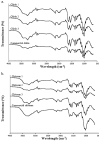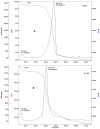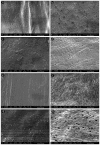Update on Chitin and Chitosan from Insects: Sources, Production, Characterization, and Biomedical Applications
- PMID: 38786507
- PMCID: PMC11118814
- DOI: 10.3390/biomimetics9050297
Update on Chitin and Chitosan from Insects: Sources, Production, Characterization, and Biomedical Applications
Abstract
Insects, renowned for their abundant and renewable biomass, stand at the forefront of biomimicry-inspired research and offer promising alternatives for chitin and chitosan production considering mounting environmental concerns and the inherent limitations of conventional sources. This comprehensive review provides a meticulous exploration of the current state of insect-derived chitin and chitosan, focusing on their sources, production methods, characterization, physical and chemical properties, and emerging biomedical applications. Abundant insect sources of chitin and chitosan, from the Lepidoptera, Coleoptera, Orthoptera, Hymenoptera, Diptera, Hemiptera, Dictyoptera, Odonata, and Ephemeroptera orders, were comprehensively summarized. A variety of characterization techniques, including spectroscopy, chromatography, and microscopy, were used to reveal their physical and chemical properties like molecular weight, degree of deacetylation, and crystallinity, laying a solid foundation for their wide application, especially for the biomimetic design process. The examination of insect-derived chitin and chitosan extends into a wide realm of biomedical applications, highlighting their unique advantages in wound healing, tissue engineering, drug delivery, and antimicrobial therapies. Their intrinsic biocompatibility and antimicrobial properties position them as promising candidates for innovative solutions in diverse medical interventions.
Keywords: biomedical; biopolymer; carbohydrate valorization; characterization; environmental applications; extraction; industrial; insect chitosan.
Conflict of interest statement
The authors declare no conflicts of interest.
Figures









Similar articles
-
Analysis, Properties, and Applications of Insect-Derived Chitosan: A Sustainable Path to Functional Polysaccharide Materials.Gels. 2025 Apr 15;11(4):291. doi: 10.3390/gels11040291. Gels. 2025. PMID: 40277727 Free PMC article. Review.
-
Recent insights into the extraction, characterization, and bioactivities of chitin and chitosan from insects.Trends Food Sci Technol. 2020 Nov;105:17-42. doi: 10.1016/j.tifs.2020.08.016. Epub 2020 Sep 4. Trends Food Sci Technol. 2020. PMID: 32901176 Free PMC article. Review.
-
Characterization of chitin and chitosan derived from Hermetia illucens, a further step in a circular economy process.Sci Rep. 2022 Apr 22;12(1):6613. doi: 10.1038/s41598-022-10423-5. Sci Rep. 2022. PMID: 35459772 Free PMC article.
-
Chitin and Chitosan: Production and Application of Versatile Biomedical Nanomaterials.Int J Adv Res (Indore). 2016 Mar;4(3):411-427. Epub 2016 Mar 1. Int J Adv Res (Indore). 2016. PMID: 27819009 Free PMC article.
-
Insect residues as an alternative and promising source for the extraction of chitin and chitosan.Int J Biol Macromol. 2024 Jan;254(Pt 3):127773. doi: 10.1016/j.ijbiomac.2023.127773. Epub 2023 Nov 3. Int J Biol Macromol. 2024. PMID: 37923048
Cited by
-
Sulfation affects apical extracellular matrix organization during development of the Drosophila embryonic salivary gland tube.bioRxiv [Preprint]. 2025 Aug 18:2024.11.20.624565. doi: 10.1101/2024.11.20.624565. bioRxiv. 2025. PMID: 40631256 Free PMC article. Preprint.
-
The Role of Insect-Based Feed in Mitigating Climate Change: Sustainable Solutions for Ruminant Farming.Insects. 2025 May 13;16(5):516. doi: 10.3390/insects16050516. Insects. 2025. PMID: 40429229 Free PMC article. Review.
-
Analysis, Properties, and Applications of Insect-Derived Chitosan: A Sustainable Path to Functional Polysaccharide Materials.Gels. 2025 Apr 15;11(4):291. doi: 10.3390/gels11040291. Gels. 2025. PMID: 40277727 Free PMC article. Review.
-
Exploring the potent hydrolytic activity of chitosan-cerium complex microspheres resin for organophosphorus pesticide degradation.Heliyon. 2024 Jun 28;10(13):e33642. doi: 10.1016/j.heliyon.2024.e33642. eCollection 2024 Jul 15. Heliyon. 2024. PMID: 39027539 Free PMC article.
-
Edible Insects from the Perspective of Sustainability-A Review of the Hazards and Benefits.Foods. 2025 Apr 17;14(8):1382. doi: 10.3390/foods14081382. Foods. 2025. PMID: 40282784 Free PMC article. Review.
References
-
- Khattak S., Wahid F., Liu L.P., Jia S.R., Chu L.Q., Xie Y.-Y., Li Z.-X., Zhong C. Applications of Cellulose and Chitin/Chitosan Derivatives and Composites as Antibacterial Materials: Current State and Perspectives. Appl. Microbiol. Biotechnol. 2019;103:1989–2006. doi: 10.1007/s00253-018-09602-0. - DOI - PubMed
-
- Hahn T., Tafi E., Paul A., Salvia R., Falabella P., Zibek S. Current State of Chitin Purification and Chitosan Production from Insects. J. Chem. Technol. Biotechnol. 2020;95:2775–2795. doi: 10.1002/jctb.6533. - DOI
-
- Salavati M. Mechanical Properties of α-Chitin and Chitosan Biocomposite: A Molecular Dynamic Study. J. Compos. Sci. 2023;7:464. doi: 10.3390/jcs7110464. - DOI
-
- Muzzarelli R.A.A. Chitin Nanostructures in Living Organisms. In: Gupta N.S., editor. Chitin. Volume 34. Springer; Dordrecht, The Netherlands: 2011. pp. 1–34. Topics in Geobiology.
Publication types
LinkOut - more resources
Full Text Sources

